|
The United States Coast
Guard
Beginnings of the US Coast Guard
.
| The United States Coast Guard was not originally
a military force. Instead, in 1790, the new American Treasury Department
built ten law-enforcement boats to fight smugglers and insure collection
of import fees on ship cargo entering American ports.
Treasury Secretary Alexander
Hamilton convinced Congress to authorize "revenue cutters" in 1790.
|
.v |

|
.
These small cutters became the basis of the
United
States "Revenue Marine," which expected to pay for its expense by saving
revenue for the Treasury Department in waterborne anti-smuggling operations.
.
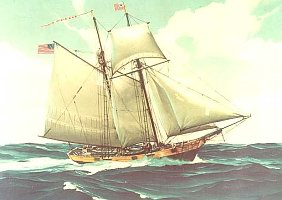
|
.v |
The Massachusetts was one
of the first ten cutters. It was in service from 1791-1792.
The painting may actually depict
the second cutter named Massachusetts, which served from 1793-1804
because it shows the Revenue ensign and commission pennant which were not
adopted until 1799. |
.
| Although the Revenue Marine was
not part of the US Navy, its flotilla of cutters constantly engaged in
offshore patrol duties and even attacked French privateers.
In 1799, an official act allowed the President
to use revenue marine vessels to supplement the Navy in times of war.
Commencing in 1807, the now-experienced revenue
service enforced new laws that banned importation of slaves into the United
States. |
... |
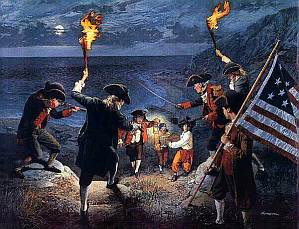 Captain William Cooke of the
Revenue Cutter Diligence seizing contraband gold from a French Privateer
in 1793.
Captain William Cooke of the
Revenue Cutter Diligence seizing contraband gold from a French Privateer
in 1793.
|
.

The Revenue Cutter Vigilant
capturing the British privateer Dart in a night engagement off Block
Island in 1813.
|
.v |
During the War of 1812, the 16 cutters of
the Revenue Marine fought off privateers, dueled British armed squadrons,
captured several prize ships, and escorted gunboats and small convoys.
The little boats were not always victorious,
but their valor and dash established the highest standards of seamanship
and bravery. |
.
The exciting record of the Revenue Marine
continued. For example, a notable expedition by the Revenue Marine destroyed
a powerful pirate base on Breton Island, freeing the Gulf Coast of rampant
piracy and white-slave trading. In 1822, the armed cutter Alabama
successfully
captured three armed slave ships from Africa, despite adamant protests
from the South. The service also enforced state quarantine laws and neutrality
regulations.
.
| Beginning in 1831, the Revenue Service rendered
assistance to ships endangered by winter storms.
In many ways, the remarkably effective Revenue
Marine armada advanced the social progress of a flowering American democracy
further than its regular Navy. |
.v |
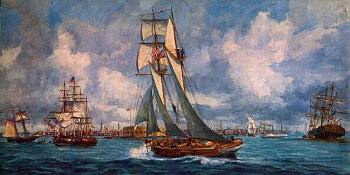
The Revenue Cutter McLane
and other cutters enforcing revenue laws in Charleston Harbor in 1833.
|
.
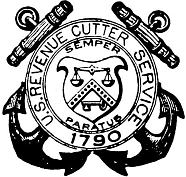
U.S. Revenue Cutter Service Seal
|
...
. |
The three purposes of the Revenue Marine were
now firmly established:
(1) Military service in wartime.
(2) Law enforcement.
(3) Maritime safety.
|
.
The schooners and steamers of the service
contributed to success in the Mexican War;
intercepted illegal slave-ships and liberated
their unfortunate human cargoes wherever possible;
participated in legal duties associated with
such novel ventures as the California gold rush, and rescued shipwreck
victims. |
..... |
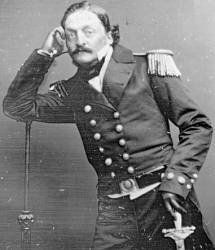 Third Lieutenant Henry H. Key,
USRM, wearing the Revenue Marine officer's uniform, circa 1855-1857.
Third Lieutenant Henry H. Key,
USRM, wearing the Revenue Marine officer's uniform, circa 1855-1857.
|
.
The Revenue Marine fought most valiantly in
the Civil War. The service had always attempted to end slavery, and fired
the first shot in the Civil War when its Harriet Lane encountered
the rebel steamer Nashville trying to run past Union Fort Sumter
(soon lost to Confederate bombardment).
.
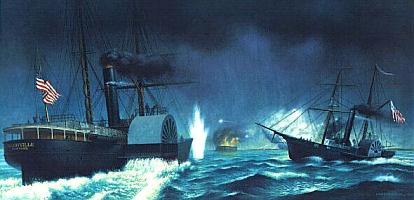
The Cutter Harriet Lane
fires across the bow of Nashville in 1861.The Harriet Lane Revenue
Marine's cutters first successful steam side wheeler.
|
.
Throughout the war, the service's gallant
flotilla of steamers, tugs, yachts and oceangoing vessels isolated Confederate
forts, freed endangered coastal slaves, and landed Union Army troops at
critical points along the enemy-held southern coast.
.
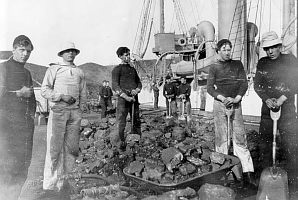 Crewmen of the The U.S. Revenue
Cutter Bear loading coal for the ship, c. 1895. The Bear
was active in Alaska waters from 1885 to the 1920s.
Crewmen of the The U.S. Revenue
Cutter Bear loading coal for the ship, c. 1895. The Bear
was active in Alaska waters from 1885 to the 1920s.
|
.v |
By the time that the terrible war ended, the
"Revenue Cutter Service" (as it was popularly called) had emerged as champions
of human liberty.
Unfortunately, the daring little cutters and
their valiant boat-handlers often paid dearly under the fire of rebel shore
batteries and slaveholder ambushes during courageous expeditions to save
endangered Blacks. |
.
| The Spanish-American War of 1898 reinforced
the service's wartime display of exemplary bravery. At the Battle of Cardenas,
the cutter Hudson boldly refused to leave a badly damaged Navy torpedo
boat being pummeled by several Spanish gunboats. The Hudson gallantly
stayed in the thick of action and managed to tow the Navy boat out of danger.
Each officer of the Hudson received
a gold or silver medal of honor from Congress -- the only gold and silvers
congressional medals awarded during the entire war. |
... |
 U.S. Revenue Cutter Hudson
rescuing
the torpedo boat Winslow in May 1898.
U.S. Revenue Cutter Hudson
rescuing
the torpedo boat Winslow in May 1898.
|
.

The U. S. Revenue Cutter Miami
close to an iceberg
|
.v |
Meanwhile, the Revenue Cutter Service expanded
its peacetime maritime safety duties.
In 1914, following the tragic loss of the ocean
liner Titanic to an iceberg, the service established the internationally
famous ice patrol of the North Atlantic. This tradition continues to the
present day. |
.
A year later in 1915, the US Treasury Department
combined its two operations, the Revenue Cutter Service and the Lifesaving
Service, into one organization. The new entity was designated as the United
States Coast Guard.
.
 .
.
.
.
[ I. Development ]..[
II. Facts about the SPARS ]..[
III. Uniforms ]..[
IV. Sources ]
|

